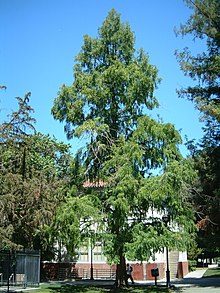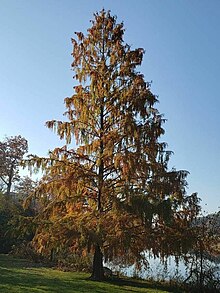Sequoia, Sequoya or Sequoyah may refer to:
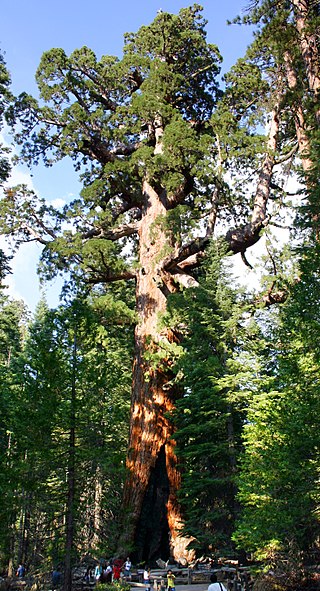
Sequoiadendron giganteum, also known as the giant sequoia, giant redwood or Sierra redwood is a coniferous tree, classified in the family Cupressaceae in the subfamily Sequoioideae. Giant sequoia specimens are the most massive trees on Earth. They occur naturally only in groves on the western slopes of the Sierra Nevada mountain range of California.
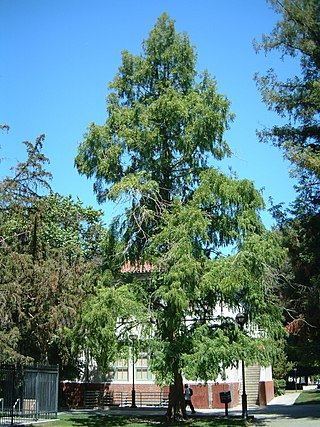
Metasequoia glyptostroboides, the dawn redwood, is a fast-growing, endangered deciduous conifer. It is the sole living species of the genus Metasequoia, one of three genera in the subfamily Sequoioideae of the family Cupressaceae. It now survives in the wild only in wet lower slopes and montane river and stream valleys in the border region of Hubei and Hunan provinces and Chongqing municipality in south-central China, notably in Lichuan county in Hubei. Although the shortest of the redwoods, it can grow to 167 ft (51 m) in height.
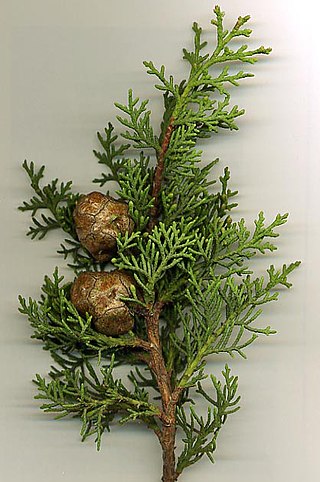
Cupressaceae is a conifer family, the cypress, with worldwide distribution. The family includes 27–30 genera, which include the junipers and redwoods, with about 130–140 species in total. They are monoecious, subdioecious or (rarely) dioecious trees and shrubs up to 116 m (381 ft) tall. The bark of mature trees is commonly orange- to red-brown and of stringy texture, often flaking or peeling in vertical strips, but smooth, scaly or hard and square-cracked in some species.

Cryptomeria is a monotypic genus of conifer in the cypress family Cupressaceae, formerly belonging to the family Taxodiaceae. It includes only one species, Cryptomeria japonica. It used to be considered by some to be endemic to Japan, where it is known as Sugi. The tree is called Japanese cedar or Japanese redwood in English. It has been extensively introduced and cultivated for wood production on the Azores.

Cunninghamia is a genus of one or two living species of evergreen coniferous trees in the cypress family Cupressaceae. They are native to China, northern Vietnam and Laos, and perhaps also Cambodia. They may reach 50 m (160 ft) in height. In vernacular use, it is most often known as Cunninghamia, but is also sometimes called "China-fir". The genus name Cunninghamia honours Dr. James Cunningham, a British doctor who introduced this species into cultivation in 1702 and botanist Allan Cunningham.

Athrotaxis is a genus of two to three species of conifers in the cypress family, Cupressaceae. The genus is endemic to western Tasmania, where they grow in high-elevation temperate rainforests.
The Chester M Alter Arboretum is an arboretum located on the campus of the University of Denver, 2467 South Vine Street, Denver, Colorado.

Lichuan is a county-level city of the Enshi Tujia and Miao Autonomous Prefecture, in southwestern Hubei province, People's Republic of China, located 52 kilometres (32 mi) west of Enshi City, the prefecture seat. It borders Chongqing Municipality to the southwest, west, and north. It has approximately 870,000 inhabitants.
Wan Chun Cheng or Zheng Wanjun was a Chinese botanist. Initially one of the Chinese plant collectors who followed in the wake of the Europeans after 1920, he became one of the world's leading authorities on the taxonomy of gymnosperms. Working at the National Central University in Nanjing, he was instrumental in the identification in 1944 of the dawn redwood, Metasequoia glyptostroboides previously known only from fossils. The plant Juniperus chengii is named in his honour.
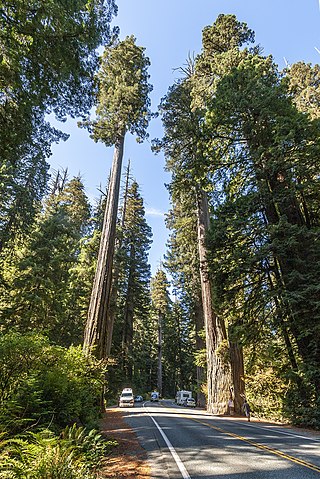
Sequoia sempervirens is the sole living species of the genus Sequoia in the cypress family Cupressaceae. Common names include coast redwood, coastal redwood, and California redwood. It is an evergreen, long-lived, monoecious tree living 1,200–2,200 years or more. This species includes the tallest living trees on Earth, reaching up to 115.9 m (380.1 ft) in height and up to 8.9 m (29 ft) in diameter at breast height. These trees are also among the longest-living organisms on Earth. Before commercial logging and clearing began by the 1850s, this massive tree occurred naturally in an estimated 810,000 ha along much of coastal California and the southwestern corner of coastal Oregon within the United States.

Sequoioideae, commonly referred to as redwoods, is a subfamily of coniferous trees within the family Cupressaceae. It includes the largest and tallest trees in the world. The subfamily achieved its maximum diversity during the Jurassic and Cretaceous periods.

Sequoia is a genus of redwood coniferous trees in the subfamily Sequoioideae of the family Cupressaceae. The only extant species of the genus is Sequoia sempervirens in the Northern California coastal forests ecoregion of Northern California and Southwestern Oregon in the United States. The two other genera in the subfamily Sequoioideae, Sequoiadendron and Metasequoia, are closely related to Sequoia. It includes the tallest trees, as well as the heaviest, in the world.
Metasequoia foxii is an extinct redwood species in the family Cupressaceae described from numerous fossils of varying growth stage. The species is solely known from the Paleocene sediments exposed in central Alberta, Canada. It is one of three extinct species belonging to the redwood genus Metasequoia.

Sequoia affinis is an extinct species of the genus Sequoia in the cypress family Cupressaceae.

Sequoiadendron is a genus of evergreen trees, with two species, only one of which survives to the present:

Metasequoia occidentalis is an extinct redwood species of the family Cupressaceae that is found as fossils throughout the Northern Hemisphere. It is one of three extinct species of Metasequoia that are currently recognized as valid.

Glyptostrobus europaeus is an extinct conifer species of the family Cupressaceae that is found as fossils throughout the Northern Hemisphere. The sole living species of Glyptostrobus was described from China in 1926. The name of the genus comes from the Greek "glypto" meaning grooved or carved, and "strobilus" meaning cone. The species name "europaeus" refers to the fact that it was first described from Europe.
This fossil flora in Turkey stems from at least six Pliocene deposits in Güvem and Beşkonak villages, 80 kilometres (50 mi) north of Ankara, 22 kilometres (14 mi) north of Kızılcahamam and 125 kilometres (78 mi) south of the Black Sea coast. They are 1,000 metres (3,300 ft) to 1,500 metres (4,900 ft) above sea level, extending 15 kilometres (9.3 mi) north-south and 7 kilometres (4.3 mi) east-west. Between six and seven million years ago, a fresh water lake existed there in a forested area with mostly broad leaved deciduous tree species, dominated by sequoia and oak.

Metasequoia heerii is an extinct redwood species of the family Cupressaceae that is found as fossils throughout the Northern Hemisphere. It is one of several proposed extinct species of Metasequoia that were previously referred to Sequoia.
